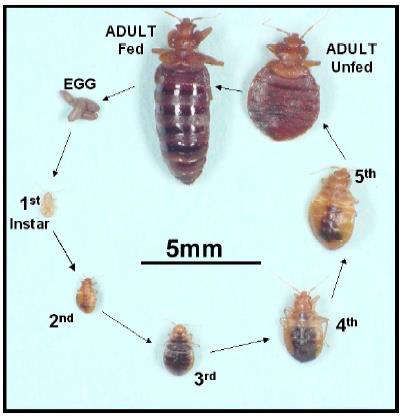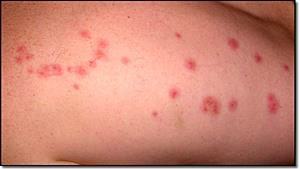Bedbugs
Bedbugs, including Cimex lectularius, the common bedbug, and C. hemipterus, the tropical bedbug, are flat, brown insects that bite humans to obtain a blood meal

- there over 75 species of Insecta: Hemiptera: Cimicidae, commonly known as “bed bugs,” a hematophagous arthropod of the family Cimicidae within the order of Hemiptera
- 2 genuses and species implicated in human infestations are Cimex lectularius and Cimex hemipterus
- C hemipterus lives in tropical environments, but C lectularius is an urban dweller
- C lectularius can live practically anywhere - various descriptions of the odour emitted from these arthropods exist, a common smell associated with an infestation is the odor of berries, herbs, or a musty, stale, sweet odour (2)
- called the “cryptic bed bug”because it is able to hide in small spaces and many believe it to be invisible
- a mature C lectularius is approximately the size of an apple seed (2)
- C lectularius have a distinct odour
- 2 genuses and species implicated in human infestations are Cimex lectularius and Cimex hemipterus
- bedbugs cannot fly or jump (1) (2)
- adult C lectularius are brachypterous, which means they have rudimentary wings, small wings in the front and almost absent behind, which prevents them from being able to fly
- move fast, about 1 metre per minute
- life cycle of a bedbug comprises seven stages: egg, five nymphal stages, and adult (2)
- adult bedbugs that have a food source live up to 4 to 5 months; on average, starved bedbugs (at any life stage) at room temperature will die within 70 days (1)
- US Centers for Disease Control and Prevention fact sheets have recently reported that C lectularius is not a vector of disease; however, there is evidence that C lectularius could transmit Trypanosoma cruzi, the parasite that causes Chagas disease (3)
- but to date, bedbugs have not been implicated in transmission of infectious agents to humans (1)
Life Cycle of the Common Bedbug, Cimex lectularius:

- after mating, C. lectularius females lay 1 to 10 cream-colored eggs, 1 mm long each, per day throughout their adult lives
- C. lectularius females lay approximately 200 (up to 500) eggs in a lifetime
- C. hemipterus (tropical bedbugs) lay up to 50 eggs in a lifetime
- bedbugs are dependent on humans - however bedbugs may feed on a wide variety of other warm-blooded animals
- bedbugs of both sexes in all nymphal and adult stages require blood to accomplish their life cycle
- nymphs require at least one blood meal to molt to the next stage
- every 3 to 5 days, a bedbug must feed for 3 to 5 minutes to get a complete engorgement before molting to the next stage
- after feeding, the fifth-stage nymph molts into an adult, and an egg can hatch and reach adulthood in only 35 days (2) - once they reach adulthood, they can survive for up to 1 year
- these developmental stages of the bedbug explain how a previously unknown bedbug presence in a newly infested site achieves exponential multiplication by the end of the first month
- bedbugs fear light and are generally active in the dark - they hide in any small dark place, such as bedclothes, mattresses, springs, bed frames, cracks, crevices, and wallpaper
Recognizing Bed Bug Bites
bites on arm:

For more information about bed bugs including more images of bed bug bites then click here
- bed bug bites may be undetected until enough bites occur to cause irritation or a skin rash (2) - bite may initially go undetected because bed bug saliva contains an anesthetic. An allergic response to the saliva can produce inflammation that becomes a reason for medical concern
- immunosenescence or immunosuppression due to medications or medical diseases may result in reduced, delayed, or no allergic response to bed bug bites. Due to differences in individual sensitivity to the bites, it is possible for persons sleeping in the same bed to have variable responses
- resemble bites from other insects and arthropods
- typically no red spot in centre (such as with fleas)
- typically occur on exposed skin
- rarely occur on the palms or soles (such as with scabies or mites)
- often occur in rows or groups
- confirmation based on finding bed bug evidence
Eradication:
- mechanical methods (including vacuuming and heating or freezing) are essential to eradicate bedbugs
- commercial insecticides are frequently used - however these are of limited effectiveness because of resistance - it is noted that in settings where insecticides are used, they should be combined with mechanical methods (1)
Notes:
- bed bugs are found worldwide from fancy hotels to ordinary homes - however, bed bugs seem to leave some people alone (even if they sleep in the same bed) and some people have almost no reaction to the bites, and so it is often difficult for people to accept that their home has bed bug (5)
Reference:
- Parola P, Arezki I. Bedbugs. N Engl J Med 2020;382:2230-7.
- McNeil C et al. Bed Bugs: Current Treatment Guidelines. Journal of Nursing Practitioners 2017; 13(6):381-8
- US Centers for Disease Control and Prevention. DPDx - laboratory identification of parasitic diseases of public health concern: bed bugs. 2013
- Greenburg C. Don’t Let the Bed Bugs Bite!!! (presentation). New Mexico Department of Health (Accessed 5/6/2020).
- Norton SA, Pollack RJ. Bed Bugs. JAMA Dermatol. Published online July 10, 2024. doi:10.1001/jamadermatol.2024.0099
Related pages
Create an account to add page annotations
Annotations allow you to add information to this page that would be handy to have on hand during a consultation. E.g. a website or number. This information will always show when you visit this page.